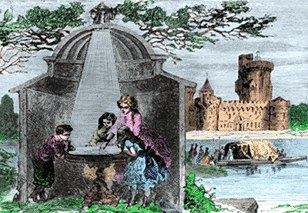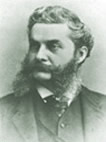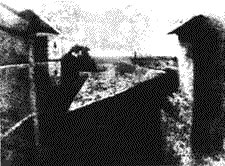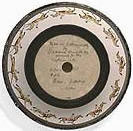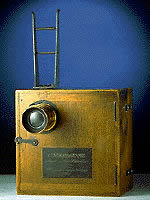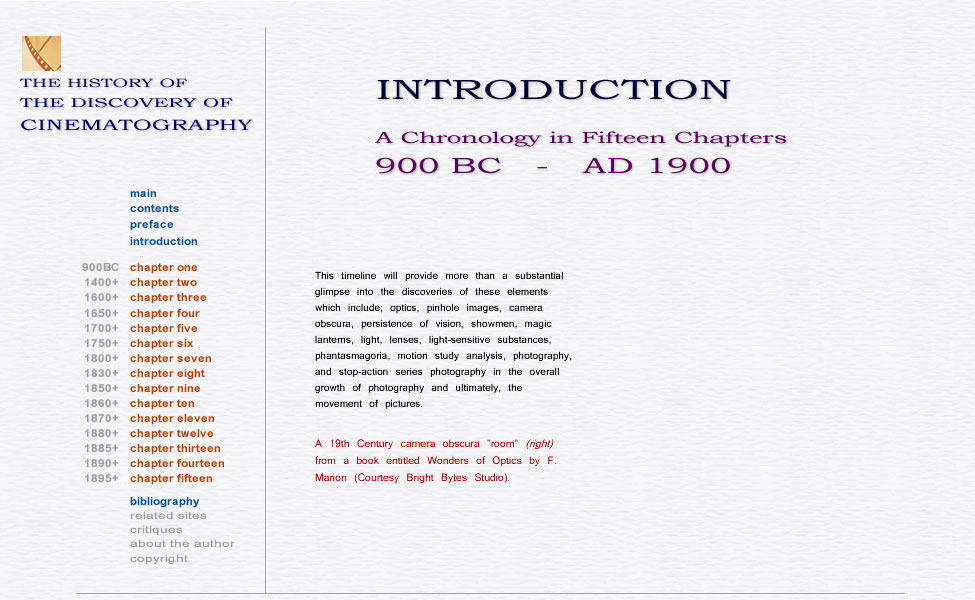 |
| |
| |
This subject has a rich
history attached to it. In order to understand the full discovery and
development of moving pictures, we must study the various elements of
not only this medium, but all others which are related to cinematography
and especially photography. |
|
| |
|
|
|
| |
This chronology is presented
in fifteen chapters, and represents an exhaustive and historical overview
on the subject of cinematography. It encompasses among others, the works
of Layard, Sophocles, Herodotus, Empodocles, Mo Ti, Plato, Aristotle,
Democritus, Euclid, Archimedes, Shao Ong, Vitruvius, Lucretius, Pablius
Statius, Pliny, Seneca, Heron, Ptolemy, Ting Huan, Galen, Boethius, Geber,
Chao-Lung, Kuang-Hsien, Alhazen, Avicena, Shen Kua, Averroes, Grosseteste,
Bacon, Magnus, Witelo, Peckham, Saint-Cloud, Villeneuve, Gershon, Fontana,
Alberti, Gainsborough, Vinci, Maurolycus, Caesariano, Durer, Reinhold,
Gemma-Frisius, Cardano, Porta, Barbaro, Fabricius, Diggs, Risner, Danti,
Benedetti, Casciorolo, Kepler, Scheiner, Sala, Snell, D'Aguilon, Drebbel,
Gassendro, Schwenter, Leurechon, Bate, Kircher, Descartes, Horrocks, Herigone,
Martini, De Chales, Zahn, Niceron, Huygens, Schott, Walgensten, Vermeer,
Reeves, Hooke, Boyle, D'Orleans, Balduin, Kohlans, Cellio, Homberg, Molyneux,
Sturm, John Harris, Van Gravensande, Van Musschenbroek, Schulze, Bion,
Cheselden, Guyot, Smith, Cuff, Caneletto, Costa, Nollet, Parrat, Dollond,
De la Roche , Ledermuller, Martin, Van Loo , Brander, Sheraton, Schropfer,
Priestley, Seraphin, Lambert, Boulton, Scheele, Joseph Harris, Storer,
Charles, Wedgewood, Balsamo, Chretien, Guinard, Harrup, Robertson, Hare,
Davy, Philipsthal, Wollaston, Niepce, Brewster, Chevalier, Talbot, Herschel,
Dageurre, Gurney, Birckbeck, Roget, Ritchie, Fitton, Paris, Drummond,
Barker, Farraday, Wheatstone, Plateau, Stampfer, Marey, Janssen, Anschutz,
Muybridge, Horner, Donisthorpe, Lumiere's, Goodwin, Eastman, Dickson,
Casler, Friese-Greene, Carbutt, LePrince, Edison and others. |
|
| |
|
|
| |
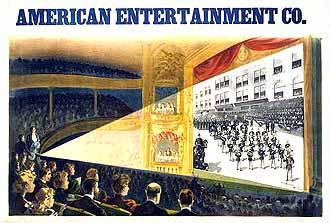 |
Marion reported
in his book, of the work of GIOVANNI BATTISTA DELLA PORTA. In
reference to the images that Porta observed through the camera
obscura effect, Marion stated;
"this was the first attempt at the formation
of a camera obscura, an instrument that has bestowed such incalculable
benefits on humanity".
These were engaging words indeed, although the research involved
was limited. However, like others before and since, Marion failed
to delve deeper into the true history of the camera obscura, a
discovery which would lead to photography, and ultimately, cinematography.
We hereby take the liberty to present such a history . . . |
|
|
| |
|
|
| |
INTRODUCTION |
|
| |
The word ‘cinema’
comes from ‘Kinema’-toscope and is derived from the Greek
word kinema-matos meaning the science of pure motion. |
|
| |
|
|
| |
This is a retrospective
history of the dawn of film, and a pre-history of cinema itself. The body
of this text deals with the origin of motion pictures and the ancestors
of cinema beginning several millenia before the birth of Jesus Christ
our Saviour, and culminating in the final decade of the nineteenth century.
Film historians differ in their opinion of what is the birth year of film.
There are some who put it as early as 1891 and others who claim it to
be as late as 1897. Regardless, motion pictures were born when the technical
aspects of the primitive camera, and projector, reached a point where
images could be projected in such a manner as to depict movement. For
instance, Donisthorpe and Le Prince both pre-date what is considered the
premiere films of the Lumieres. |
|
| |
|
|
|
| |
Yet
they receive little if any attention due to the lack of commercialism
associated with their work. |
|
| |
|
|
|
| |
Our purpose here is not
to induce controversy around the parentage of commercial cinema, or the
year it finally came of age. Nor do I want to argue about the difference
between projected painted disks vs. disks with photographs, or celluloid
versus sensitized paper strips. It is to provide factual data on the grounds
of well documented material. |
|
| |
|
|
|
| |
A Brief History of Pre-Cinema |
|
|
| |
Cinematography is defined
simply as the illusion of movement by projecting in rapid fashion, many
still pictures. Also known as motion pictures, movies or moving pictures,
cinematography is a product of nineteenth century ingenuity and experimentation. |
|
| |
|
|
|
| |
Motion pictures came to
be as the result of numerous other inventions. A large segment of the
discoverers came from the new field of photography. Many more came from
those who worked with magic lanterns. Some were interested in projecting
images, and then others studied how images could be recorded on different
materials such as leather and paper. But these were not the only men interested
in watching real-life motion unfold before their eyes. |
|
| |
|
|
|
| |
People like Oliver Wendall
Holmes desired to enhance prosthetics for post civil war amputees. Others
like the scientist E. Jules Marey studied the motion of animals and particularly
birds, in flight. British born American photographer Eadweard Muybridge
also studied animals in motion but humans as well. By the end of the century,
all of these discoveries, experiments and inventions came together to
form the art we now call as movies, videos or cinema. Since man was first
created, he has had an insatiable thirst to re-create his own movements.
His first attempts were simple drawings of animals, showing them in their
natural stride. Primitive, but effective enough for his needs and desires.
And it is in fact this driving desire to not only create and re-create,
but to continually improve on his previous works that allows for man to
produce a superior, more enhanced version of the original. |
|
| |
|
|
| |
 |
Even before men desired
to capture images on paper, and make them move, we have been fascinated
by such simple pleasures as eastern shadow plays, pinhole images
and lanthorns. Whether it was observing images of light cast upon
the ground through the intertwined leaves on trees, the ascending
paper cut-outs from a flame or hand operated puppets in China
and Greece, man has wanted to witness the reproduction of movement
made by his own hands.
< Even
Plato's cave images strike a tremendous similarity to today's
movie. |
|
|
| |
|
|
| |
Pinhole Images |
|
|
| |
Pinhole images have been
seen since the time of man's creation. Those who may have dwelt in caves
or similar structures, including tents, saw the pinhole image. This was
therefore, the most primitive of camera obscuras. What men saw were images
and shapes flickering through the tiny holes made in the unexpected holes
of hide coverings and the like. |
|
| |
|
|
|
| |
Pinhole photography on
the other hand is the capturing of those images and shapes using no lens.
A tiny hole replaces the lens. Light passes through the hole and an image
is formed in the back wall of the camera. The image is of course upside
down because light travels in straight lines and therefore crosses at
the aperture (hole). If an outdoor scene is seen, the sky is at the bottom
and ground at the top. Early showmen like Villanova and Cardano required
the use of the lens to right the image seen. |
|
| |
|
|
|
| |
The basic optical principles
of the pinhole are commented on in Chinese texts from the fifth century
BC. Chinese writers had discovered by experiments that light travels in
straight lines. The philosopher Mo Ti was the first to record the formation
of an inverted image with a pinhole or screen. Mo Ti was aware that objects
reflect light in all directions, and that rays from the top of an object,
when passing through a hole, will produce the lower part of an image.
|
|
| |
|
|
|
| |
There is no further reference
to the camera obscura in Chinese texts until the ninth century AD, when
Tuan Chheng Shih refers to an image in a pagoda. Shen Kua later corrected
his explanation of the image. Yu Chao-Lung in the tenth century used model
pagodas to make pinhole images on a screen. |
|
| |
|
|
|
| |
In Greece, Aristotle (fourth
century B.C.) comments on pinhole image formation in his work Problems.
In Book XV, 6, he asks: "Why is it that when
the sun passes through quadri-laterals, as for instance in wickerwork,
it does not produce a figure rectangular in shape but circular?"
In Book XV, 11, he asks his readers: "Why is
it that an eclipse of the sun, if one looks at it through a sieve or through
leaves, such as a plane-tree or other broad leaved tree, or if one joins
the fingers of one hand over the fingers of the other, the rays are crescent-shaped
where they reach the earth? Is it for the same reason as that when light
shines through a rectangular peep-hole, it appears circular in the form
of a cone?" Aristotle found no satisfactory explanation to
his observation; the problem remained unresolved until the 16th century. |
|
| |
|
|
|
| |
The Arabian physicist
and mathematician Ibn Al-Haitam, also known as Alhazen, experimented with
images seen through the pinhole in the tenth century AD. He arranged three
candles in a row and put a screen with a small hole between the candles
and the wall. He noted that images were formed only by means of small
holes and that the candle to the right made an image to the left on the
wall. From his observations he deduced the linearity of light. In the
following centuries the pinhole technique was used by optical scientists
in various experiments to study sunlight projected from a small aperture. |
|
| |
|
|
|
| |
Pinhole cameras are small
or large, and improvised or designed with great care. Cameras have been
made of seashells and many have been made of oatmeal boxes, coke cans
or any size of box. Cameras have been cast in plaster like a facemask,
constructed from beautiful hardwoods, built of metal with bellows and
a range of multiple pinholes. Even cars have been used as pinhole cameras
and rooms in large buildings. In fact the camera obscura effect (pinhole
images seen within a camera) was first seen inside the cave, and later
in large rooms. |
|
| |
|
|
|
| |
The showman Villanova
performed scenes outside a room, which had a small hole in one wall. Patrons
sat inside and watched "cinema". The accompanying sounds heard outside
matched the scenes viewed inside. |
|
| |
|
|
|
| |
Pinhole images are softer
and less sharp than pictures made using a lens. The images have nearly
infinite depth of field and wide-angle images remain absolutely rectilinear.
On the other hand, pinhole images suffer from greater chromatic aberration
than pictures made with a simple lens, and they tolerate little enlargement.
Exposures are long, ranging from half a second to several hours. Images
are exposed on film or paper - negative or positive; black and white,
or color. |
|
|
|
|
|
| |
The Camera Obscura Effect |
|
| |
We will look at the effect
of the original 'camera' in it's most obscure form being able to provide
a picture, but not capable of retaining it. For three centuries alone,
a fundamental piece of equipment, the camera obscura, had been known to
man (not to mention pinhole images which pre-date the camera obscura and
were the actual effect). A great new toy of sophistication and delight,
but it had little to offer in the way of long-lasting enjoyment. It eventually
found its place in history but not before being used as a simple drawing
aid. |
|
| |
|
|
|
| |
In the Renaissance and
later centuries the pinhole was mainly used for scientific purposes in
astronomy. But as time went by the pinhole image (now known as a camera
obscura) was used more and more as a drawing aid for artists and painters.
Even Leonardo da Vinci (1452-1519) described the pinhole image in his
Codex Atlanticus. The pinhole image had come of age, and was placed in
a box, or room. Giovanni Battista della Porta (1538-1615), a scientist
from Naples, was long regarded as the inventor of the camera obscura because
of his description of the camera obscura in the first edition of his Magia
Naturalis (1558). His description has received much publicity, as did
his camera obscura shows, but he was not the true 'inventor'. |
|
|
|
|
|
| |
What appears to be the
earliest ever illustration of the camera obscura is found in a book by
Johannes De Fontana in 1420 [see
here]. The drawing shows a nun holding a vertically shaped
camera with an image on the inside. This drawing has been identified as
a magic lantern by some but can only be attributed to the camera as the
image is clearly on the inside. Magic lanterns project their images. |
|
| |
|
|
|
| |
Gemma Frisius, an astronomer,
had used the pinhole in his darkened room to study the solar eclipse of
1544. He described it along with a description in his 'De Radio Astronomica
et Geometrica' (1545). The very term camera obscura ("dark room") was
coined by Johannes Kepler (1571-1630). At this time, the term had come
to mean a room, tent or box with a lens aperture used by artists to draw
a landscape. The lens made the image brighter and focused at a certain
distance. Thus this type of camera differed from the pinhole camera obscura
used by Frisius in 1544. In the 1620s Johannes Kepler invented a portable
camera obscura. Camera obscuras as drawing aids were soon found in many
shapes and sizes. Both artists and painters used them. |
|
| |
|
|
|
| |
During the 19th century
several large scale camera obscuras were built as places of education
and entertainment. The meniscus lens, superior to the bi-convex lens,
improved the quality of the projected images. Several buildings or towers
with camera obscuras remain today: The Camera Obscura at Royal Mile, Edinburgh;
the Great Union Camera at Douglas, Isle of Man; the Clifton Observatory
at Bristol, England; the camera obscura at Portmeirion, North Wales; the
camera obscura at Santa Monica, California, and others. A few large-scale
camera obscuras have been built in the 20th century. The Giant Camera
at Cliff House, San Francisco is scheduled for demolition at the time
of this writing. A group is fighting to keep it from being destroyed. |
|
| |
|
|
|
| |
As most students of film
know, the origin of moving pictures goes back well beyond Mary Pickford
and Charles Chaplin. Contributions over two millennia by many people,
comprise the whole story of putting the full and complete picture together
of how we now view re-created motion in the form of motion pictures, or
movies. As going to the theatre today is like looking through a window
on the world, with all it's created beauty and magnificence, so too will
we now look back through the window of time to study the people and properties
of cinematography. |
|
| |
|
|
| |
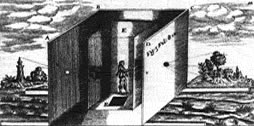 |
Camera Obscura
from Athanasius Kircher's Ars Magna Lucis
Et Umbra (The Great Art of Light and Shadow)
1646.
Originally, camera obscuras were the size of rooms and thus take
their name from the latin 'dark room'. (Ars Magna, 1st
ed. vol.10, plate 28 of vol.10, sec. 2, 1646) |
|
|
| |
|
|
| |
The Magic Lantern |
|
|
| |
The magic lantern, a projector
with a future that would inevitably become one of the most famous and
entertaining inventions in history, in many ways surpassing that of the
automobile and airplane combined. In it's primitive state, the magic lantern
was the forerunner of our current day slide projector and overhead. It
however, was without motion. Void of fluidity yet electrifying and exhilarating
in it's presentation, this little tin box with a chimney was only one
of many vital components that make up the art of seeing pictures "move".
And they all have their special place in the story, and history of cinematography. |
|
| |
|
|
| |
The
magic-lantern is the precursor of the first motion picture projector.
It was first seen and used around 1644-1645, and soon became a showman's
instrument. At the close of the 17th century, traveling showmen (lanternists)
would put on shows at any venue they could use, including castles. The
term "magic" lantern is derived from the fact that these shows featured
devils, ghosts and goblins to name a few. The name Athanasius Kircher
is most often heard when mentioning the lantern. It was originally called
its Latin name, the Lanterna Magica. |
|
| |
|
|
| |
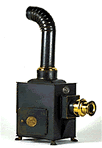 |
The Magic
Lantern is an ancient projector originally illuminated by candles
and oil lamps. Considered to be black magic, sorcery and witchcraft
when originally developed during medieval times, its inventors
were at times considered sorcerers to achieve the effects created
by projecting images on a screen. This thinking was perpetuated
in the 18th and 19th centuries with the coming of the phantasmagorie.
<
The little tin box with a chimney, the Magic Lantern. In 1640,
Athanasius Kircher will present a slide show recognized to be
the first use of the candle-lit lantern. |
|
|
| |
|
|
| |
By the end of the nineteenth
century, magic lanterns were found everywhere; schools, homes, theatres,
churches and most other public places. They became as integral a part
of society as movie theatres are today. There were toy lanterns for children,
large wooden and brass lanterns, with single, double and triple lenses.
Lanternslides were hand-painted in full colour and projected onto a screen
as large as movie screens today. A soloist provided sound effects and
musical accompaniment as part of the show and the audience. |
|
| |
|
|
| |
 |
It is commonly
thought that the origins of the magic lantern go back to the early
17th century, almost two hundred years before the first photographs
were made. Athanasius Kircher is the name synonymous with the
magic lantern. However it must be mentioned that approximately
one hundred and forty years before Kircher's lantern in 1644,
Leonardo gave us an amazing drawing of a magic lantern. It clearly
showed a condensing lens, candle and chimney. None of Leonardo's
writings indicate any hint of him actually projecting images.
<
This illustration from the master strongly suggests a figure of
some type between the candle and lens. |
|
|
| |
|
|
| |
The Phantasmagoria |
|
|
| |
In English this theatrical
phenomenon was known as the Phantasmagoria. There were as many professionals
at it as there were itinerant traveling showmen with their lanterns. One
of the original and most elaborate of them all was E'tienne Gaspard Robert.
He later changed his name to Robertson. His demonstrations of the lantern
were slick theatrical productions designed and performed to scare people
to death. Apparitions, ghosts and the like would appear from nowhere and
literally frighten patrons from their seats. This macabre entertainment
created quite a stir in the closing years of the 18th century. |
|
| |
|
|
|
| |
Robertson's varied performances
would often use multiple lanterns. Fades, pans, dolly shots and rear projection
were some of the tools of the artists which today are taken for granted
as modern Hollywood creations. In America, Joseph Boggs Beale was considered
the foremost magic lantern artist. |
|
| |
|
|
|
| |
|
|
| |
| The Phantasmagoria
shows were often held in old run-down monasteries and chapels
to add to the effect. The dark and sombre surroundings were ideal
for special effects much like those created through Dolby surround
sound and darkened theatres of today. Showmen used waxed sheets
to catch images from "moving" lanterns on wheels and smoky rooms
allowed images to float and "hang" in the air. Joseph
Boggs Beale (1841-1926) > |
|
|
|
| |
|
|
| |
Elaborate nineteenth century
magic-lantern shows with a variety of themes were produced at the Royal
Polytechnic Institute in London. The Polytechnic was built specifically
for magic lantern shows and was part of a museum. As Terry Borten of the
American Magic Lantern Theatre states; "From
1838 to 1876, the Polytechnic produced extraordinary shows that dazzled
two generations. The shows used giant lanterns with slides that were sometimes
two feet long. Over 900 "Polytechnic" slides were exquisitely painted
by the specialist firm of Childe and Hill, and Childe's dissolving views
and elaborate special effects were an important part of the shows' popularity.
The program was changed regularly during the year and included battlefront
reports of the current wars, and fairy tales such as Aladdin's Lamp. The
highlight of the year was The Christmas Special, featuring (of course)
Dickens' classics like "Gabriel Grubb." |
|
| |
|
|
|
| |
Persistence Of Vision |
|
|
| |
Man's ancient desire to
make likenesses of himself and his environment found new satisfaction
when he became able to reproduce movement through the fluid medium of
film. As we can trace the history of photography back over centuries until
the first photograph was taken in 1826 by Joseph Niepce, so can we look
back to the ancestors of cinematography. |
|
| |
|
|
|
| |
The first modern steps
toward motion pictures were those taken in the direction of the study
of persistence of vision. The investigation of this subject appears to
have been conducted on a serious note by Peter Mark Roget in 1824. |
|
| |
|
|
|
| |
Roget presented a scientific
paper detailing his studies and called it `Persistence of Vision with
Regard to Moving Objects'. The phenomenon itself was not only known in
the 19th century. When digging deep into the history of any subject we
can be astounded at what we find. |
|
| |
|
|
|
| |
Aristotle himself spoke
of after-images. |
|
| |
|
|
|
| |
In 1832 Joseph A. F. Plateau
and Simon Ritter von Stampfer in Vienna, Austria, independently of one
another, discovered an identical method for creating the illusion. They
used flat disks which were perforated with a number of evenly spaced slots.
Around the rim of the disk were an equal number of hand-drawn figures.
Each figure showed successive phases of movement. Holding the device with
the figures facing a mirror, the viewer spun the disk and looked through
the slots. |
|
| |
|
|
|
| |
The figures reflected
in the mirror appeared to move. Plateau's device, the phenakistoscope,
and Stampfer's, the stroboscope, led to the invention of more elaborate
devices using the same principle, such as the zoetrope. |
|
| |
|
|
|
| |
Such optical "toys"
became popular in 19th-century homes. |
|
| |
|
|
|
| |
Photography |
|
|
| |
One of the most important
constituents in the discovery of motion pictures was the photograph. Like
almost all other discoveries throughout time, photography was the result
of accumulated technical knowledge covering a period of no less than three
hundred years. In fact, just like the pinhole image effect preceded the
camera obscura's construction, so did the knowledge of light-sensitive
substances precede the actual harnessing of the fixed image through the
photograph. The effect of light on silver compounds had been known for
almost one hundred years itself, dating back to 1727 when it was discovered
that silver halides turned black when exposed to the sun. But the photograph
by itself would have to wait patiently until the coming of celluloid before
re-created motion could be achieved. |
|
| |
|
|
|
| |
This text will examine
that entire history, from the pinhole image to the screen. Our purpose
is to provide the most thorough, exhaustive and sweeping view of every
component, which makes up the medium of film and to give life and sustenance
to it in the process.
Chronologically presented, THE HISTORY OF THE DISCOVERY OF CINEMATOGRAPHY
encompasses an historical and factual re-creation of it's own, combining
all of the properties of cinematography and the persons responsible
for their discovery or invention, and linking those pieces together
into an ever unfolding story. The actual vision that many of these personalities
had during their involvement in this fascinating process of creativity,
production and improvement is astounding. |
|
| |
|
|
| |
Earliest Extant Photograph
Joseph Nicephore
Niépce is credited with producing the world's first permanently
captured "image", which he called a Heliograph (or Sun Drawing).
Niépce's photograph was made in 1826 and was taken from a window
looking out across the rooftops of the Niépce home. He used a
pewter plate that was sensitized with bitumen of Judea. The photograph
was made in a camera obscura and took an eight-hour exposure.
The extant photograph is 8" x 6.5" and resides at the Harry Ransom
Humanities Research Center, The University of Texas at Austin.
It was discovered by chance, in the 1950's in London when found
along with letters written by Niepce. |
|
| >
This photograph is part of the Gernsheim Collection and is known
as “View From The Window At Grasâ€. In 1813, Niépce obtained
an image but it was not fixed, and eventually faded. (Courtesy
the Gernsheim Collection, Ransom Centre, University of Texas,
Austin), (Thanks to Robert Carter, Photographic Historical Society
of Canada). |
|
|
| |
|
|
| |
Two men, each playing
their own vital part in the unraveling of history as it pertains to the
motion of pictures, were Eadweard Muybridge and Thomas Alva Edison. Well
documented throughout the history of photography are the photographs taken
by Muybridge of cats, dogs and the famous trotting horse. Muybridge concentrated
his life's work on the study of the motion of humans and animals. His
work in stop-action series photography is only one example, by one man,
of the continual and improving way this medium matured. |
|
| |
|
|
|
| |
Thanks to a simple
wager regarding the movement of a horse's legs during a trot, Muybridge
began to pave the way for cinematography to become an eventual reality
of this world. It was almost as if he knew the extent to which his work,
and it's direction would go in the next century. He actually spoke of
the coming of film during his last years. As quoted from the preface of
his book "Animals In Motion" published in 1898, Muybridge writes
. . .
The combination of a Kinetoscope and Phonograph has not been satisfactorily
accomplished. There can however be but little doubt that in the future
. . . . an entire opera with the gestures, facial expressions, and songs
of the performers with all the accompanying music, will be recorded and
reproduced by an apparatus for the instruction or entertainment of an
audience. And if the photographs have been made stereoscopically, and
each series be independently and synchronously projected on a screen,
a perfectly realistic imitation of the original performance will be seen,
in the apparent "round", by the use of properly constructed binocular
glasses." --
Eadweard Muybridge |
|
| |
|
|
| |
 |
Muybridge's
Zoopraxiscope of 1879 (left) and a disk (right) used
in the Zoopraxiscope |
|
|
|
| |
|
|
| |
Motion Study Analysis |
|
|
| |
By 1877 the increased
speed of photographic emulsions and improved camera shutters made it possible
to photograph rapid motions. Pioneers such as Muybridge and Marey were
interested in motion rather than in photography. Their combined studies
and experimentation's in stop-action series photography and motion study
analysis have led to wonderful inventions within modern times. |
|
| |
|
|
|
| |
To study the gait of a
running horse, Eadweard Muybridge, an English born book-seller turned
photographer, set up on a racetrack in California a row of 12 cameras
that had electric shutter controls. As a horse ran by the cameras, it
tripped strings that activated the shutters and exposed the plates. |
|
| |
|
|
|
| |
Muybridge repeated the
experiment using 24 cameras. In this way the first instantaneous photographs
of un-posed, continuous motion were made. Muybridge's work led to many
experiments in motion photography aimed at achieving the same results
with a single camera. |
|
| |
|
|
|
| |
A Frenchman, Étienne-Jules
Marey, who was also studying the movement of living things, first accomplished
this in 1882. Marey perfected the "photographic gun," shaped like a rifle
but with a lens in the muzzle and photographic dry plates in the chamber.
With only one pull of its trigger, 12 exposures were made in rapid succession.
|
|
| |
|
|
|
| |
Marey later improved the
gun by using emulsified paper film instead of dry plates and was able
to take about 100 pictures a second. His paper film, however, could not
be projected. The next important step in taking pictures was the development
of a light-sensitive emulsion on Celluloid film. This was achieved by
Hannibal Goodwin, an American amateur photographer from Newark, N. J.,
in 1887. |
|
| |
|
|
|
| |
A short time later George
Eastman, also an American, marketed a similar transparent, flexible film
to be used with the Kodak camera he invented. Celluloid film, though highly
flammable, could be manufactured in continuous fashion, rapidly exposed
by intermittent motion, quickly passed through a projecting device, and
easily wound. |
|
| |
|
|
|
| |
Another giant step taken
towards motion pictures was the one taken by Baron Franz von Uchatius,
an Austrian military officer, who combined the revolving disk principle
with the magic lantern to project a series of phased drawings on a wall
or screen. Uchatius perfected his projection apparatus between 1845 and
1853. His pictures could be viewed by a number of people at one time.
During the years that these men were discovering how to make pictures
move and how to project them, others were pioneering in the development
of photography. |
|
| |
|
|
|
| |
By the middle of the 19th
century, still photographs began to replace drawings on optical disks.
However, due to the long exposure time required by the wet-plate process
then in use, each phase of a motion had to be posed and photographed separately.
By 1870, inventors in the United States and England had developed devices
in which posed photographs of motion, mounted on a revolving disk, passed
between a light source and a lens for projection for an audience. These
mechanisms created an illusion of motion, but it was not yet possible
for the photographer to capture on film the objects in motion. |
|
| |
|
|
|
| |
Frenchman Louis-Augustin
Le Prince who lived primarily in Leeds England, in 1888 patented a machine
to film and project images using Celluloid film. Le Prince never showed
his cinematograph pictures to anyone other that his co-workers and those
in employment at the Whitley factory where he had his shop. This fact
has lessened his impact on the history. Without an official announcement
and documented coverage of a 'first showing', Le Prince was left out of
predominance for the most part. However, no other strip of working film
has been discovered that predates the Leeds bridge traffic scene of 1888.
|
|
| |
|
|
|
| |
The extant film shot by
Le Prince but never shown publicly or announced to the world, was presented
seven years before the Lumiere's cafe presentation to workers in the Whitley
factory where Le Prince performed his work. Le Prince used non-perforated
sensitized paper for these frames which remain twenty in all. |
|
| |
|
|
|
| |
Commercialization Of Film |
|
|
| |
The first people generally
credited with using celluloid film for motion pictures were the American
inventors Thomas A. Edison and his assistant William K.L. Dickson. |
|
| |
|
|
|
| |
By 1890 they had developed
the Kinetograph, a motion-picture camera using Eastman film. To view the
film, the Edison laboratory developed this peep-show machine within a
cabinet which ran a continuous 50-foot loop of 35-mm film driven by sprockets.
A revolving shutter allowed a brief glimpse of each image. |
|
| |
|
|
|
| |
On April 14, 1894, the
first Kinetoscope parlour opened at 1155 Broadway in New York City. It
was an arcade containing banks of Kinetoscope machines, which featured
motion pictures of vaudeville acts, Wild West and circus shows, and other
entertainment. They were filmed at the "Black Maria," the world's first
motion-picture studio, built by Edison at West Orange, N.J., in 1892-93.
By the end of 1894, other Kinetoscope parlours had opened in the United
States and Europe. |
|
| |
|
|
|
| |
Perhaps better known
for his contribution to the quality of life than the entertaining aspect
of it, Edison wrote on the moral demeanor of the finished product to his
contemporaries while being honoured at a birthday gala in 1924. He too
saw the vast potential, not just from an entertainment aspect, but also
from a reputable and ethical one. Edison had an uncanny intuition and
incredible foresight of what the future held. He spoke these words to
motion picture industry executives almost thirty years after the first
reels had been turned . . . . .
"I believe, as I have always believed, that you control the most powerful
instrument in the world for good or evil. Remember that you are servants
of the public and never let a desire for money or power prevent you from
giving to the public the best work of which you are capable. It is not
the quantity of riches that count; it is the quality that produces happiness,
where that is possible. I wish you a prosperous, useful, and honorable
future." --T.
A. Edison |
|
| |
|
|
| |
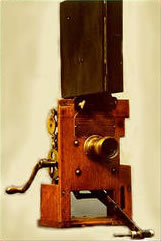 |
The success
of Edison's machines inspired other experimenters to improve on
his devices and to try to find a means of projecting films for
large audiences. In 1895 a number of new motion-picture cameras
and projection devices--some within the same machine--were demonstrated
in the United States and Europe. The most successful was the Cinematographe
- a combination camera, printer, and projector--invented by Louis
and Auguste Lumière in France.
They gave their first private film show in March 1895, and in
December they began public showings at the Grand Café in Paris.
These were almost immediately popular, and in 1896 the Lumière's
converted a room at the café into the world's first cinema theatre.
The Cinématographe spread rapidly through Europe, and in 1896
it was imported into the United States.
<
Edison's 35mm Kinetoscope of 1902 (Courtesy Michael Rogge Collection)
|
|
|
| |
|
|
| |
To meet the competition
of films projected on a screen, Edison arranged to manufacture the Vitascope,
a projector developed by Thomas Armat and Charles Francis Jenkins in the
United States. The Armat-Jenkins projector was the first American one
to use the principle of intermittent motion, allowing each frame to remain
stationary on the screen for a brief time. |
|
| |
|
|
| |
Like the Europeans, Edison
also developed a portable motion-picture camera that could take films
anywhere. On April 23, 1896, Edison's first public performance using the
Vitascope opened at Koster and Bial's Music Hall in New York City with
films of prizefighters, dancing girls, a scene from a play, and ocean
waves. With the development of the Vitascope, all of the basic tools of
cinematography were finally available. |
|
| |
|
|
| |
|
|
| |
So it is
with man in his more civilized and educated state when he draws
on his innate and natural urge to expand and go beyond what his
senses say is unexplainable. Society's magnetic attachment to
watching films today is no different than the drawing power that
pinhole images had on Aristotle. Nor is today's attraction to
television, videos or computer games any stronger than Venetians
of the 13th century viewing Villeneuve's moving shows. Great film
directors of today pursue the finishing touches of their artwork
at the same speed and obsession as the pioneer's of previous centuries
pursued theirs.
Lumière
Brothers 1895 Cinematographe (Source: Smithsonian National Museum
of American History) > |
|
|
|
| |
|
|
| |
Only technology changes,
and technology is the culminating factor in the final presentation of
any product, especially in the medium of movement re-creation. In fact,
technology is the final presentation because it becomes the improved version
of itself. The subject matter of any scenario remains stationary among
all versions until technological advances bring it to a new plateau, a
new height of enjoyment through it's own technological phases of expansion. |
|
| |
|
|
|
| |
Film has been defined
as a photographic projection of continuous still images. In contrast to
chronophotography, it has been called a technical device for achieving
the illusion of motion by photographic means. Regardless of whatever description
one gives to the definition of motion pictures, it remains without doubt,
a monumental discovery within history. |
|
| |
|
|
|
| |
I invite you now, to view
the chronology of events leading from the pinhole image to the silver
screen.
This is the genesis of the cinema. |
|
| |
|
Paul Burns |
|
| |
|
|
|
| |
|
|
|
| |
"Our
invention can be exploited for a certain time as a scientific curiosity,
but apart from that, it has no commercial future whatsoever." --Auguste
Lumière |
|
| |
|
|
|
| |
|
|
|
| |
|
|
|

|
| |


